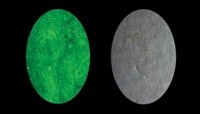Advertisement
Grab your lab coat. Let's get started
Welcome!
Welcome!
Create an account below to get 6 C&EN articles per month, receive newsletters and more - all free.
It seems this is your first time logging in online. Please enter the following information to continue.
As an ACS member you automatically get access to this site. All we need is few more details to create your reading experience.
Not you? Sign in with a different account.
Not you? Sign in with a different account.
ERROR 1
ERROR 1
ERROR 2
ERROR 2
ERROR 2
ERROR 2
ERROR 2
Password and Confirm password must match.
If you have an ACS member number, please enter it here so we can link this account to your membership. (optional)
ERROR 2
ACS values your privacy. By submitting your information, you are gaining access to C&EN and subscribing to our weekly newsletter. We use the information you provide to make your reading experience better, and we will never sell your data to third party members.
Analytical Chemistry
Luminescent nanoparticles leave a glowing fingerprint
New material could improve the resolution of fingerprint patterns detected at crime scenes
by Melissae Fellet, special to C&EN
December 4, 2017
| A version of this story appeared in
Volume 95, Issue 48

Nanoparticles with long-lived luminescence have been shown to provide sharp images of otherwise invisible fingerprints, offering better resolution than does standard fingerprinting for forensic investigation, the researchers say (Anal. Chem. 2017, DOI: 10.1021/acs.analchem.7b03003). Quan Yuan of Wuhan University and colleagues synthesized Zn2GeO4 nanorods containing 1.0% gallium and 0.5% manganese that are similar to persistently luminescent nanoparticles they have used for biomedical imaging. The researchers modified the nanoparticle surface with activated esters that can bond to amino acids left behind in the ridges of fingerprints. Fingerprints developed with the glowing nanoparticles show more defined ridges than ones dusted with conventional black fingerprint powder. The particles also reveal clear fingerprints even 60 days after the prints are deposited—a potential benefit of this approach since the proteins, oils, and perspiration that form invisible fingerprints decompose over time, making the detection of aged prints with traditional techniques challenging. Yuan says a forensic research institute in Beijing is interested in further testing the nanoparticles.





Join the conversation
Contact the reporter
Submit a Letter to the Editor for publication
Engage with us on Twitter